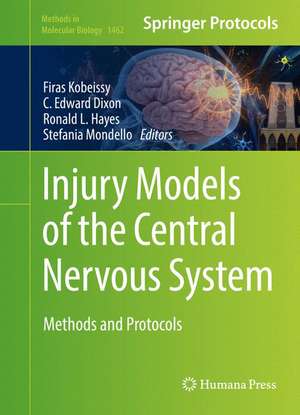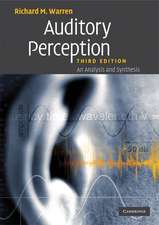Injury Models of the Central Nervous System: Methods and Protocols: Methods in Molecular Biology, cartea 1462
Editat de Firas H. Kobeissy, C. Edward Dixon, Ronald L. Hayes, Stefania Mondelloen Limba Engleză Hardback – 8 sep 2016
Practical and thorough, Injury Models of Central Nervous Systems: Methods and Protocols, is a very useful reference towards theprogress of this discipline.
| Toate formatele și edițiile | Preț | Express |
|---|---|---|
| Paperback (1) | 728.87 lei 6-8 săpt. | |
| Springer – 9 iun 2018 | 728.87 lei 6-8 săpt. | |
| Hardback (1) | 983.34 lei 6-8 săpt. | |
| Springer – 8 sep 2016 | 983.34 lei 6-8 săpt. |
Din seria Methods in Molecular Biology
- 9%
 Preț: 791.63 lei
Preț: 791.63 lei - 23%
 Preț: 598.58 lei
Preț: 598.58 lei - 20%
 Preț: 882.98 lei
Preț: 882.98 lei -
 Preț: 252.05 lei
Preț: 252.05 lei - 5%
 Preț: 802.70 lei
Preț: 802.70 lei - 5%
 Preț: 729.61 lei
Preț: 729.61 lei - 5%
 Preț: 731.43 lei
Preț: 731.43 lei - 5%
 Preț: 741.30 lei
Preț: 741.30 lei - 5%
 Preț: 747.16 lei
Preț: 747.16 lei - 15%
 Preț: 663.45 lei
Preț: 663.45 lei - 18%
 Preț: 1025.34 lei
Preț: 1025.34 lei - 5%
 Preț: 734.57 lei
Preț: 734.57 lei - 18%
 Preț: 914.20 lei
Preț: 914.20 lei - 15%
 Preț: 664.61 lei
Preț: 664.61 lei - 15%
 Preț: 654.12 lei
Preț: 654.12 lei - 18%
 Preț: 1414.74 lei
Preț: 1414.74 lei - 5%
 Preț: 742.60 lei
Preț: 742.60 lei - 20%
 Preț: 821.65 lei
Preț: 821.65 lei - 18%
 Preț: 972.30 lei
Preț: 972.30 lei - 15%
 Preț: 660.49 lei
Preț: 660.49 lei - 5%
 Preț: 738.41 lei
Preț: 738.41 lei - 18%
 Preț: 984.92 lei
Preț: 984.92 lei - 5%
 Preț: 733.29 lei
Preț: 733.29 lei -
 Preț: 392.60 lei
Preț: 392.60 lei - 5%
 Preț: 746.26 lei
Preț: 746.26 lei - 18%
 Preț: 962.66 lei
Preț: 962.66 lei - 23%
 Preț: 860.22 lei
Preț: 860.22 lei - 15%
 Preț: 652.64 lei
Preț: 652.64 lei - 5%
 Preț: 1055.50 lei
Preț: 1055.50 lei - 23%
 Preț: 883.87 lei
Preț: 883.87 lei - 19%
 Preț: 491.89 lei
Preț: 491.89 lei - 5%
 Preț: 1038.86 lei
Preț: 1038.86 lei - 5%
 Preț: 524.16 lei
Preț: 524.16 lei - 18%
 Preț: 2122.34 lei
Preț: 2122.34 lei - 5%
 Preț: 1299.23 lei
Preț: 1299.23 lei - 5%
 Preț: 1339.12 lei
Preț: 1339.12 lei - 18%
 Preț: 1390.26 lei
Preț: 1390.26 lei - 18%
 Preț: 1395.63 lei
Preț: 1395.63 lei - 18%
 Preț: 1129.65 lei
Preț: 1129.65 lei - 18%
 Preț: 1408.26 lei
Preț: 1408.26 lei - 18%
 Preț: 1124.92 lei
Preț: 1124.92 lei - 18%
 Preț: 966.27 lei
Preț: 966.27 lei - 5%
 Preț: 1299.99 lei
Preț: 1299.99 lei - 5%
 Preț: 1108.51 lei
Preț: 1108.51 lei - 5%
 Preț: 983.76 lei
Preț: 983.76 lei - 5%
 Preț: 728.16 lei
Preț: 728.16 lei - 18%
 Preț: 1118.62 lei
Preț: 1118.62 lei - 18%
 Preț: 955.25 lei
Preț: 955.25 lei - 5%
 Preț: 1035.62 lei
Preț: 1035.62 lei - 18%
 Preț: 1400.35 lei
Preț: 1400.35 lei
Preț: 983.34 lei
Preț vechi: 1199.18 lei
-18% Nou
Puncte Express: 1475
Preț estimativ în valută:
188.17€ • 201.21$ • 156.89£
188.17€ • 201.21$ • 156.89£
Carte tipărită la comandă
Livrare economică 17 aprilie-01 mai
Preluare comenzi: 021 569.72.76
Specificații
ISBN-13: 9781493938148
ISBN-10: 1493938142
Pagini: 700
Ilustrații: XXIV, 743 p. 157 illus., 104 illus. in color.
Dimensiuni: 178 x 254 x 41 mm
Greutate: 1.53 kg
Ediția:1st ed. 2016
Editura: Springer
Colecția Humana
Seria Methods in Molecular Biology
Locul publicării:New York, NY, United States
ISBN-10: 1493938142
Pagini: 700
Ilustrații: XXIV, 743 p. 157 illus., 104 illus. in color.
Dimensiuni: 178 x 254 x 41 mm
Greutate: 1.53 kg
Ediția:1st ed. 2016
Editura: Springer
Colecția Humana
Seria Methods in Molecular Biology
Locul publicării:New York, NY, United States
Cuprins
The History and Evolution ofExperimental Traumatic Brain Injury Models.- Clinical Traumatic Brain Injury inthe Preclinical Setting.- RodentModels of Traumatic Brain Injury: Methods and Challenges.- TraumaticBrain Injury Models in Animals.- SystematicReview of Traumatic Brain Injury Animal Models.- Methodsof Drug Delivery in Neurotrauma.- Bridgingthe Gap of Standardized Animals Models for Blast Neurotrauma: Methodology for Appropriate Experimental Testing.- CellularMechanisms and Behavioral Outcomes in Blast-Induced Neurotrauma: ComparingExperimental Set-Ups.- Applicationof Systems Biology to Neuroproteomics: The Path to Enhanced Theranostics forTraumatic Brain Injury.- Role of Systems Biology in BrainInjury Biomarker Discovery: A Neuroproteomic Application.- TheControlled Cortical Impact Model of Experimental Brain Trauma: Overview,Research Applications, and Protocol.- WeightDrop Models in Traumatic Brain Injury.- Midline(Central) Fluid Percussion Model of Traumatic Brain Injury.- Lateral(Parasagittal) Fluid Percussion Model of Brain Injury.- ImpactAcceleration Model of Diffuse Traumatic Brain Injury.- ExperimentalModels for Neurotrauma Research.- A Porcine Modelof Traumatic Brain Injury via Head Rotational Acceleration.- PediatricRodent Models of TraumaticBrain Injury.- ModelingPediatric Brain Trauma: Piglet Model of Controlled Cortical Impact.- ThromboembolicModel of Cerebral Ischemia and Reperfusion in Mice.- AnimalStroke Model: Ischemia/Reperfusion and Intracerebral Hemorrhage.- CombinedNeurotrauma Models: Experimental Models Combining Traumatic Brain Injury and SecondaryInsults.- Microdialysis as ClinicalEvaluation of Therapeutic Hypothermia in Rat Subdural Hematoma Model.- Repetitive Transcranial MagneticStimulation as a Novel Therapy in Animal Models of Traumatic Brain Injury.- ExperimentalModels Combining TBI, Hemorrhagic Shock, and Hypoxemia.- ExperimentalModels Combining Traumatic Brain Injury and Hypoxia.- AnimalModels of Post-Traumatic Seizures and Epilepsy.- Closed-HeadTBI Model of Multiple-Morbidity.- CognitiveEvaluation Using Morris Water Maze in Neurotrauma.- Assessmentof Cognitive Function in the Water Maze Task: Maximizing Data Collection and Analysisin Animal Models of Brain Injury.- DetectingBehavioral Deficits Post Traumatic Brain Injury in Rats.- Advancedand High Throughput Method for Mitochondrial Bioenergetics Evaluation inNeurotrauma.- Determinationof Vascular Reactivity of Middle Cerebral Arteries from Stroke and Spinal CordInjury Animal Models Using Pressure Myography.- Assessment of Basilar Artery Reactivityin Stroke and Subarachnoid Hemorrhage Using Wire Myograph.- Magnetic Resonance Imaging in ExperimentalTraumatic Brain Injury.- A Simplified Workflow for ProteinQuantitation of Rat Brain Tissues Using Label-Free Proteomics and SpectralCounting.- Phenotypic Screening of Small-MoleculeInhibitors: Implications for Therapeutic Discovery and Drug Target Developmentin Traumatic Brain Injury.- Postnatal Neural Stem Cells inTreating Traumatic Brain Injury.- A Novel Biopsy Method for IsolatingNeural Stem Cells from the Subventricular Zone of the Adult Rat Brain for AutologousTransplantation in CNS Injuries.- Challenging the Paradigms of ExperimentalTBI Models: From Preclinical to Clinical Practice.
Textul de pe ultima copertă
This volume discusses experimental brain injury models thatcontain valuable information carefully chosen to widen the researchers’ horizonabout neurotrauma. Injury Models of Central Nervous System: Methods and Protocols contains relevant experimental design approaches that have beenadapted and made ready for application in laboratory settings. For easiernavigation, the chapters are categorized into 6 parts: Introduction, GeneralConsideration in Using Animal Laboratory in CNS Injury Research, Classical TBIModels and Their Link with Pathophysiological Features of CBS Injury – Models,Special Topics in CNS Trauma: Comorbid Conditions in CNS Injury, OutcomeMeasures in Brain Injury Models, and Future Directions. Written in the highly successful Methods inMolecular Biology series format, chapters include introductions to theirrespective topics, lists of the necessary materials and reagents, step-by-step,readily reproducible laboratory protocols, and tips on troubleshooting andavoiding known pitfalls.
Practical and thorough, Injury Models of Central Nervous Systems: Methods and Protocols is a very useful reference towards theprogress of this discipline.
Practical and thorough, Injury Models of Central Nervous Systems: Methods and Protocols is a very useful reference towards theprogress of this discipline.
Caracteristici
Includes cutting-edge methods and protocols Provides step-by-step detail essential for reproducible results Contains key notes and implementation advice from experts Includes supplementary material: sn.pub/extras













